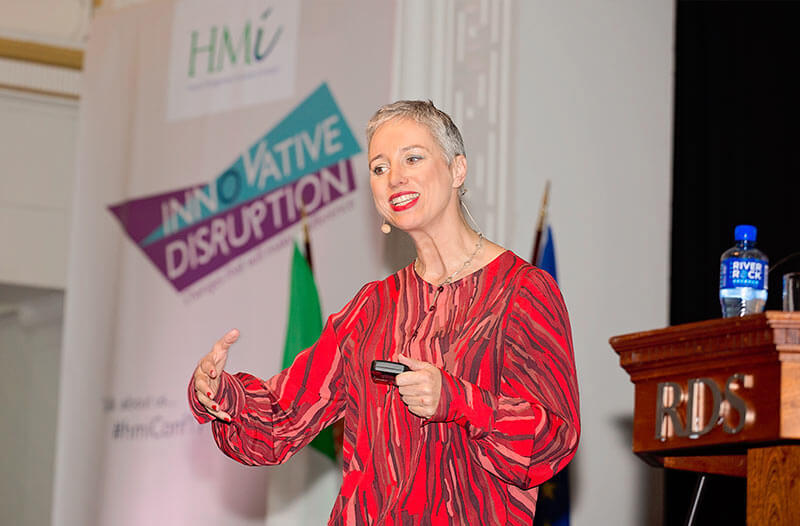Joy in work was an essential resource for the enterprise of healing and the gifts of hope, confidence, and safety that health care should offer patients and families could only come from a workforce that felt hopeful, confident, and safe, Dr. Emma K. Stokes, Associate Professor and Deputy Head of Physiotherapy, at Trinity College, Dublin and President of the World Confederation of Physiotherapy, told the Conference.

Speaking on “Faster horses, on change we want, need and is best,” she asked those attending the conference to consider if the change they wanted was the change they needed and if the change they wanted would enable the change that was needed.
“Henry Ford said ‘if I’d asked people what they wanted they would have said faster horses.’”
Henry Ford said ‘if I’d asked people what they wanted they would have said faster horses.’
She said we should think about reframing how we thought about change, so that it would include bringing joy back into our work, creating space for ourselves and for others.
Dr. Stokes said The Institute for Healthcare Improvement, in its framework for improving joy at work, had concluded that with increasing demands on time, resources, and energy, in addition to poorly designed systems of daily work, it was not surprising health care professionals were experiencing burnout at increasingly higher rates, with staff turnover rates also on the rise. Yet, joy in work was more than just the absence of burnout or an issue of individual wellness; it was a system property.
The IHI said burnout led to lower levels of staff engagement, patient experience, and productivity, and an increased risk of workplace accidents. Lower levels of staff engagement were linked with lower-quality patient care, including safety, and burnout limited providers’ empathy — a crucial component of effective and person-centered care.
So, what could health care leaders do to counteract this epidemic? IHI believed an important part of the solution was to focus on restoring joy to the health care workforce. Joy in work was an essential resource for the enterprise of healing. Staff could not give what they did not have.
The white paper was intended to serve as a guide for health care organisations to engage in a participative process where leaders asked colleagues at all levels of the organization, ‘What matters to you?’ — enabling them to better understand the barriers to joy in work, and co-create meaningful, high-leverage strategies to address these issues.
It described the following:
- The importance of joy in work.
- Four steps leaders can take to improve joy in work.
- The IHI Framework for Improving Joy in Work: nine critical components of a system for ensuring a joyful, engaged workforce.
- Key change ideas for improving joy in work, along with examples from organizations that helped test them.
- Measurement and assessment tools for gauging efforts to improve joy in work.
“Joy in work is an essential resource for the enterprise of healing. You should think about what matters to you, what makes for a good day for you, what makes you proud to work where you work and when you are at our best, what does that look like?
“Identify the impediments to joy in work – the ‘pebbles in your shoes.’ Managing local ‘impediments’ does not ignore the ‘boulders’ of system wide changes but it does empower local change.”
Joy in work was an essential resource for the enterprise of healing.
Dr. Stokes said according to Helen Bevan and Steve Fairman in “The new era of thinking and practice in change and transformation: A call to action for leaders of health and care” there were five enablers of change:
- Activate the disrupters
- Lead transformation from the edge
- Change your story
- Curate rather that create
- Build bridges.
Contrasting the dominant approach and emerging direction she said the dominant approach was power through hierarchy, mission and vision, making sense through rational argument, leadership driven (top down) innovation, tried and tested based on experience and transactions.
The emerging direction was power through connection, shared purpose, making sense through emotional connection, viral (grass-roots driven) creativity, ‘open’ approaches, sharing ideas and data, co-creating change and relationships.
“Seamus Heaney said ‘the marvelous was as permissible as the matter of fact.’
“Orla Tinsley, who wrote ‘Salty Baby, My Story,’ said that “Sometimes in science it can be hard to reach for the marvellous. We are taught that science is a place of precision & parameters when really these are the elements we need to step into the space of the marvellous.
“’Once we know the rules we must not be afraid to push forward and learn how to bend and even break them in ways that can be calculated and revelatory. Having the courage and the compassion to do that is my challenge to you. These are the actions that will change the world.’
“So, do we need faster horses or change that is wanted, needed and for the best?”

